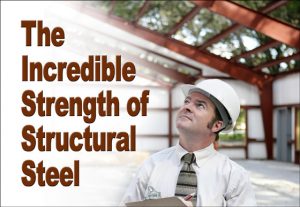Why Metal Buildings Stand Straighter, Stronger, and Longer
Have you ever thought about how much we depend on the strength of steel? Probably not. Steel has become such a part of our daily lives, we scarcely notice it.
However, would you trust yourself to drive in traffic in a car made of aluminum or wood? Would you like to work in a high-rise building made of nailed together lumber? Would you feel comfortable driving across a concrete bridge that was not reinforced with steel? Of course not.
The Strength of Steel Shaped Our Nation
 People instinctively trust in the strength of steel. Why? Because we’ve seen how steel performs all our lives.
People instinctively trust in the strength of steel. Why? Because we’ve seen how steel performs all our lives.
Steel has literally changed the history of the world.
- Great steel locomotives, gliding down gleaming steel rails, made transcontinental passage across the U.S. possible.
- Modern skyscrapers would not be possible without steel.
- Old-fashioned wooden bridges are quaint, but only steel could span great distances like the Golden Gate Bridge.
- Trucks, cars, submarines, and great ships all depend on the strength of steel.
What is Strength-to-Weight Ratio?
You have doubtless heard that steel boasts the greatest strength-to-weight ratio of any commonly used building material. But what does that mean?
Strength-to-weight ratio compares a building material’s inherent strength to its weight. Basically, the strength-to-weight ratio indicates the point at which a building material will fail to support its own weight under stress.
An engineering formula, dividing the material’s maximum imposed load by its density, yields the strength-to-weight ratio. Other terms used for strength-to-weight ratio include specific strength, breaking length, and self-support length.
Consistent Quality in Building Materials
Every species of wood varies in strength. Even within the same species, lumber’s strength differs from location to location. Consequently, determining the exact strength of wood is impossible.
Concrete’s strength varies too, based on the sources of the cement, sand, water, and gravel used, as well as the exact proportions mixed to produce the concrete.
Steel, on the other hand, is produced to exacting specifications. Steel’s strength is consistent. Its structural performance is known and verifiable.
Steel’s greater specific strength means pre-engineered steel buildings produce stronger, more durable structures with far less material and labor than concrete or wood buildings.
Buildings Under Duress
Unlike wood or concrete, prefabricated steel buildings flex with applied force. That means under the stress of hurricane-force winds or strong earthquakes, steel buildings are far less likely to fail.
The bolt-and-nut connections of a pre-engineered steel building also offer an additional advantage. Under stress, these “moment connections” allow additional flexibility. The framing members rotate slightly around the bolt-and-nut connections.
However, under sufficient force, concrete connections can give, causing the structure to crack and crumble. Nail connections in lumber-framed buildings often fail under stress.
Even weld-up steel buildings lack the flexibility of pre-engineered steel buildings. Consequently, weld-up steel buildings sometimes fail at the connection, breaking the weld.
No other type of low-rise structure offers the strength and endurance of a pre-engineered steel building.
Building with the Strength of Steel
Become a man or woman of steel! Choose RHINO Steel Building Systems for your next low-rise commercial, industrial, or personal construction project.
Speak to a RHINO metal building advisor now for details, helpful tips, free quotes, and more. Call RHINO at 940.383.9566.
Need a steel building in a hurry? Ask about our new HyperBuilt steel building series.
